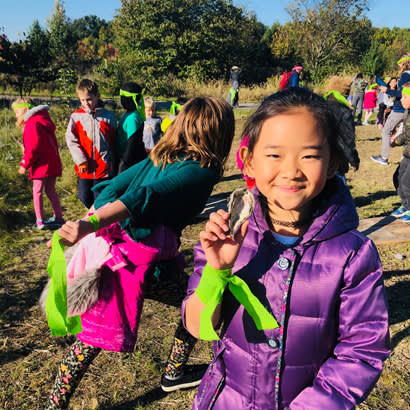
Pictured: A young student smiles while holding a milkweed pod at West Park in Carmel, Indiana. Photo courtesy of Audrey Cooper, Carmel Clay Parks & Recreation.
Many roles within the park and recreation profession require project management as a key skill. Numerous project management models exist and can be helpful to follow. Restoration projects often follow a four-phase framework: planning, design, implementation and aftercare. Let’s walk through each phase. I’ll share ways you can engage your community in each phase and provide a real-life example.
Planning
Planning is a critical first step to creating a mission, goals and objective for your project. In West Park in Carmel, Indiana, Carmel Clay Parks & Recreation identified an area of the property that was a quality site for native and pollinator-friendly plants. As a department, we have committed to planting native plants in our parks and promoting pollinator habitat. We have informed our community on the importance of pollinator habitat through programs such as Parks for Pollinators BioBlitz and Monarch tagging events.
Tips:
- Identify a mission or goal you can rally your community around.
- Find community organizations that share your goal and can support your project.
Design
Depending on the scale of a project, the design might be heavily in the hands of engineers, landscape architects or ecologists. However, your community — informed by your goals and objectives — can assist with design decisions. Provide opportunities to share designs — selected with restoration in mind — with your community to receive their input.
For our West Park project, students at a local elementary school rallied around the idea of increasing pollinator habitat at the park. Through our after-school program, these students learned about pollinators and how planting native plants, such as milkweed, can support pollinators like monarch butterflies. Park staff presented to these students a variety of native plants that would grow successfully at that site and students were able to select what to plant.
Tips:
- Allow for community input on designs, guided by restoration professionals.
- Give the youth in your community a voice to help shape your project design.
Implementation
This phase of project management is most visible to the community since it often involves park closures, construction equipment and earth moving. However, you can continue to include your community in the implementation phase. In fact, they can be some of your best volunteers since they want to enjoy the final product of their work. Volunteers can assist in planting seeds, plugs, trees, spreading mulch, watering and so much more!
In West Park, our pollinator-friendly plantings required some site preparation by park staff. However, the seed planting was completed by the same elementary students who participated in the project design. In an after-school field trip, 20 students planted common milkweed seeds to increase the pollinator habitat in the park.
Tip:
- Identify the parts of project implementation in which your community can participate.
Aftercare
After the restoration is finished, you cannot forget aftercare. If your restoration project involves plantings, your community members are invaluable for this phase. Aftercare can be active, such as watering and weeding, or passive, such as monitoring. This allows community members of various abilities to be invested in the project. Monitoring can be as simple as walking the site regularly and looking for signs of distress or disturbance to plantings. This information is vital in case action needs to be taken to ensure the restoration is successful.
At West Park, following the milkweed plantings, the project site was monitored by volunteers to watch for establishments and maturity. Four years later, the milkweed at this site was established and produced seed pods. Volunteers collected 20 percent of the seed pods from this site to continue increasing pollinator habitat in the Midwest through a project with Pollinator Partnership. Four years later, this restoration site not only provides habitat for pollinators, but it is producing enough seeds to create habitat elsewhere!
Tip:
- Keep your community aware of the project after construction or planting by enlisting their help to monitor, water, weed, etc.
Here are a few more tips when planning to engage your community in a project:
- Select a site the community can connect with and see regularly.
- Invite the community to see the site through all phases of the project (as safely as you can with construction limits).
- Incorporate all generations in your engagements! Today’s playground users are tomorrow’s park leaders.
In the four phases of restoration project management, everyone can participate! Your community is ready and waiting for the opportunity to engage in your restoration projects. I learned from the West Park project how ready people are to help when informed and given the opportunity. How have you engaged your community in restoration projects? What project is missing that community engagement? How can you involve them? Comment below and share your story.
Audrey Cooper, MNR, CPRP is the Planning and Projects Coordinator for Carmel Clay Parks & Recreation in Carmel, Indiana. She is passionate about natural resources in the parks and educating the community on how to preserve and maintain them through everyday action and long-term planning. Connect with Audrey on LinkedIn to continue the conversation.
This blog post was written in partnership with the NRPA Young Professionals Network (YPN). Learn more about the NRPA YPN on NRPA Connect or on the YPN Facebook group.



